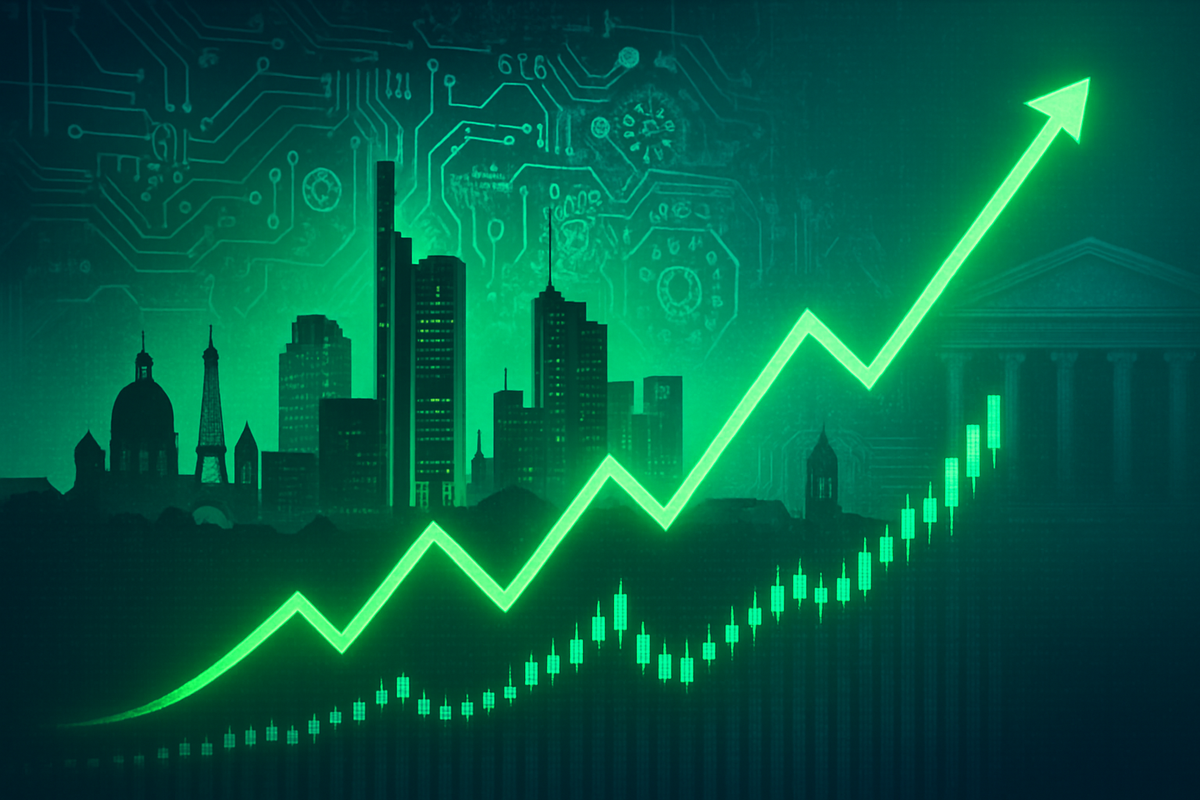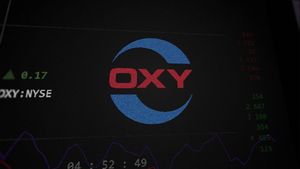
Frankfurt, Germany – October 2, 2025 – European stock markets are currently experiencing a period of unprecedented buoyancy, with several key indices reaching or nearing all-time highs. This surge is largely attributed to a robust global rally in the technology sector, particularly in artificial intelligence (AI) and semiconductor companies, coupled with growing optimism surrounding anticipated interest rate cuts by the U.S. Federal Reserve. The confluence of these factors has instilled renewed confidence in the continent's economic outlook, propelling equity valuations and drawing significant investor attention.
The pan-European STOXX Europe 600 Index hit an intraday record high of 568.5 points on October 2, 2025, building on previous record closes earlier in the year. Germany's benchmark DAX (ETR: SIE) reached 24461 points, nearing its all-time high, while France's CAC 40 (EPA: LVMH) climbed to 8048 points, having achieved its own record in March. This widespread market strength signals a positive shift in investor sentiment, as European equities demonstrate resilience and growth potential in a dynamic global financial landscape.
A Confluence of Catalysts: Tech Boom and Dovish Fed Outlook
The current rally in European markets is underpinned by specific, powerful drivers. The global tech rally, fueled by an insatiable demand for AI infrastructure and capabilities, has been a paramount force. European chip-related companies have been at the forefront of this surge. For instance, ASML Holding N.V. (AMS: ASML), a critical supplier to the semiconductor industry, and ASM International N.V. (AMS: ASM), a manufacturer of semiconductor processing equipment, have seen substantial gains. This momentum was further bolstered by news of OpenAI's significant share sale valuing the company at $500 billion, alongside reports of Samsung Electronics and SK Hynix planning to supply memory chips for OpenAI's data centers, indirectly benefiting European players in the supply chain.
Beyond semiconductors, the broader European tech ecosystem has undergone a significant transformation, with its valuation increasing fivefold since 2015 to $3.2 trillion by October 2025. This growth is supported by a tenfold increase in capital investment and an expanding talent pool. The enthusiasm around AI and cloud computing continues to drive investor interest, mirroring the strong performance of US tech giants.
Simultaneously, expectations of Federal Reserve interest rate cuts are providing a crucial tailwind. The Fed initiated an easing cycle with a 25-basis-point rate cut in September 2025, the first reduction in borrowing costs since December 2024. Market participants now widely anticipate further cuts, with a high probability (90%) of another reduction in October 2025. This "dovish pivot" from the Fed is generally bullish for equity markets, as reduced borrowing costs enhance profitability, particularly for growth, technology, consumer, and small-cap sectors. The anticipation of lower US interest rates has also led to a diminished yield advantage for the U.S. dollar, contributing to the Euro's appreciation against the dollar, which was heading towards its highest level in four years in September 2025. In contrast, the European Central Bank (ECB) completed its own easing cycle between June 2024 and June 2025, bringing its deposit facility rate to 2%, and is expected to hold rates steady for the remainder of 2025.
Winners and Losers in a Shifting Market
The current market dynamics are creating clear beneficiaries and posing challenges for various European companies and sectors.
The European technology sector stands out as a primary winner. Chipmakers like ASML (AMS: ASML), ASM International (AMS: ASM), and STMicroelectronics (EPA: STM) are directly benefiting from the AI-driven demand for advanced processors. Companies involved in digital automation and energy management, such as Schneider Electric (EPA: SU), and global payment service providers like Worldline (EPA: WLN), which recently secured a strategic partnership in the airline sector, are also seeing their shares rise. Lower borrowing costs, a consequence of anticipated rate cuts, further enhance these companies' ability to invest in R&D and expansion, while higher valuations reflect the increased attractiveness of their future earnings.
Export-oriented sectors are also poised to gain from the anticipated weakening of the U.S. dollar, which makes European goods and services more competitive internationally. Luxury goods conglomerates like LVMH Moët Hennessy Louis Vuitton (EPA: LVMH) and Kering S.A. (EPA: KER), as well as automotive giants such as Ferrari N.V. (NYSE: RACE) and Stellantis N.V. (NYSE: STLA), could see increased demand and improved profit margins. Manufacturers and chemical producers like BASF SE (ETR: BAS) are also likely to benefit from a currency advantage and potentially cheaper imported raw materials.
Conversely, the European financial sector, particularly banks, faces a mixed outlook. While some reports indicate banks are among the top performers, lower interest rates traditionally squeeze net interest margins (NIMs), impacting profitability. Furthermore, a significantly stronger Euro, while beneficial for importers, could negatively impact certain European exporters by making their products more expensive and less competitive in non-Eurozone markets. Traditional industries and less innovative companies also face the risk of disruption from the rapid advancements in technology and AI, potentially losing market share to more agile, tech-driven firms. Companies like Experian plc (LSE: EXPN) could face specific competitive pressures within their niches.
Wider Significance and Historical Context
The European market's current surge is more than just a fleeting moment; it signifies broader shifts in global finance and technology. The tech sector's leadership underscores a significant industry trend: the relentless pace of digital transformation and the central role of AI. Europe's tech ecosystem, with its robust growth in valuation and investment, is establishing itself as a formidable global player, challenging the long-held dominance of Silicon Valley.
The ripple effects are far-reaching. A potentially weaker US dollar, following Fed rate cuts, could rebalance international trade, making US exports more competitive while increasing the cost of imports. Conversely, a stronger Euro might benefit Eurozone consumers and importers but could challenge European exporters by diminishing their competitiveness. The global "AI arms race" is creating a clear divide, favoring companies that provide essential AI infrastructure and solutions while disrupting traditional business models.
Regulatory and policy implications are also significant. The European Union has positioned itself as a global leader in digital regulation with frameworks like the General Data Protection Regulation (GDPR), the Digital Markets Act (DMA), the Digital Services Act (DSA), and the AI Act. While these aim to foster fair competition, they also raise concerns about potential impediments to startup scalability and significant compliance costs for major tech firms. On the monetary policy front, the ECB's decision to hold its key interest rate at 2%, with inflation near target, contrasts with the Fed's easing cycle. This divergence influences capital flows and currency dynamics.
Historically, the rapid growth of the European tech sector, with its fivefold increase in valuation over the last decade, suggests a structural shift rather than a mere cyclical boom, differentiating it from speculative frenzies like the dot-com bubble. Comparisons can even be drawn to periods like the early 2000s when Germany, once dubbed the "sick man of Europe," underwent a significant economic turnaround, suggesting that perceived weaknesses can precede strong performance.
The Road Ahead: Opportunities and Challenges
Looking forward, the European stock market faces a complex yet promising trajectory. In the short term, Goldman Sachs Research forecasts the STOXX Europe 600 to rise approximately 5% over the next 12 months, with a total return of 8% including dividends, driven by improving economic growth and strong shareholder returns. However, European equities are now considered more expensive than earlier in 2025, though they still trade at a considerable discount relative to US stocks. A strengthening euro could also act as a drag on earnings for European companies with significant US sales, favoring domestic stocks with resilient earnings.
Long-term opportunities abound. European markets continue to offer attractive valuations compared to the US, appealing to value investors. They are also less tech-heavy and more industrially focused, providing diversification. The defense sector is poised for growth due to increased strategic investments, and Europe's leadership in renewable energy technologies presents significant investment avenues. The tech sector, particularly in AI, fintech, and biotechnology, is set for continued expansion, supported by a strong early-stage startup ecosystem. Increased fiscal spending in infrastructure, innovation, and defense is also expected to bolster growth from 2026 onwards.
However, challenges persist. Economic uncertainty and slow growth in some Eurozone regions, coupled with potential for persistent inflation and geopolitical risks (such as the war in Ukraine), could introduce volatility. Growth-stage funding gaps for European tech companies, which often rely on US investors for larger rounds, remain a concern. Furthermore, corporate earnings estimates for 2025 and 2026 are being revised lower across most sectors, despite the strong start to 2025, necessitating a highly selective investment approach.
For investors, strategic pivots are crucial. Diversification across various styles, factors, countries, and sectors is recommended, with a preference for cyclicals. Focusing on quality companies with strong fundamentals and adopting a long-term investment horizon will be vital. Given that many European companies have significant global earnings exposure, investing in European equities can provide broader international economic exposure. Mergers and acquisitions are also emerging as a dominant dealmaking strategy, focused on consolidating fragmented industries and leveraging AI efficiencies.
A New Era for European Equities
In conclusion, the European stock market's ascent to record highs marks a significant moment, reflecting a powerful confluence of a dynamic tech rally and supportive monetary policy expectations from the U.S. Federal Reserve. This period signifies a renewed confidence in Europe's economic resilience and its capacity for innovation, particularly in the burgeoning AI landscape.
Moving forward, the market is poised for continued, albeit potentially moderate, growth. While attractive valuations relative to US markets and robust sectoral opportunities exist, investors must remain vigilant. Key takeaways include the undeniable influence of AI on tech valuations, the critical role of central bank policies in shaping market sentiment, and the re-evaluation of European equities as compelling investment destinations.
Investors should closely monitor future statements and decisions from both the Federal Reserve and the European Central Bank regarding interest rates. Corporate earnings reports, particularly for tech companies, will be crucial to validate current valuations. Inflation data in both the US and Eurozone, alongside geopolitical developments and trade policies, will also significantly influence market direction. Finally, observing the breadth of the rally—whether it extends beyond large-cap tech to a wider array of sectors—will offer insights into the sustainability of the current market advance. This era could indeed mark a lasting re-evaluation of European equities, solidifying their position as a vital component of global investment portfolios.
This content is intended for informational purposes only and is not financial advice.





